Christine Valters Paintner's Blog, page 130
May 26, 2015
New Review of "The Soul of a Pilgrim"
I am honored to have my newest book The Soul of a Pilgrim: Eight Practices for the Journey Within reviewed by Claire Bangasser at A Seat at the Table:
This book came at the right time in my life. I had finally accepted the need to leave a place very dear to me. As John Valters Paintner explains in Chapter One, "The Practice of Hearing the Call and Responding":
Pilgrimage … can mean the life journeys we take in response to unwelcomed circumstances… Any time life ousts us from our places of security, we are called upon to bring ourselves fully present to our experience. We honor that even unbidden journeys can take us to places where we encounter God more closely." (21)
As some of you know, I have gone on pilgrimages to Santiago de Compostela. I have spent days walking, sixty-eight days the first time, then thirty days, then fewer and fewer. I also made a pilgrimage once to Dharamsala to listen to the Dalai Lama. A seeker by nature, I have gone on inner pilgrimages most of my life. Also, next year, we will be taking our children and grandchildren on a short pilgrimage to Santiago to celebrate my 70th birthday. This book came as a preparation for it.
May 25, 2015
Guest post from Tara Owens, author of "Embracing the Body"
I am so delighted to share these wise words about the Pentecost and the days that follow from the lovely Tara Owens, author of a wonderful new book Embracing the Body: Finding God in Our Flesh and Bone:
Tongues of Fire: What Our Bodies Tell Us About Pentecost
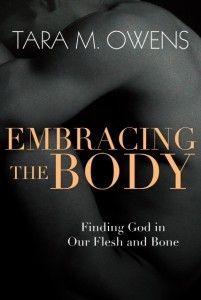 When the Day of Pentecost had fully come, they were all with one accord in one place. And suddenly there came a sound from heaven, as of a rushing mighty wind, and it filled the whole house where they were sitting. Then there appeared to them divided tongues, as of fire, and one sat upon each of them. And they were all filled with the Holy Spirit and began to speak with other tongues, as the Spirit gave them utterance.
When the Day of Pentecost had fully come, they were all with one accord in one place. And suddenly there came a sound from heaven, as of a rushing mighty wind, and it filled the whole house where they were sitting. Then there appeared to them divided tongues, as of fire, and one sat upon each of them. And they were all filled with the Holy Spirit and began to speak with other tongues, as the Spirit gave them utterance.
If you’ve ever sat around a fire late at night, staring deeply into the flames, you know that combustion is deeply physical. The crackle of the wood, the smell of smoke, the dance of the flames as they produce light and heat. We experience fire with all of our senses, reflecting back to us the spark of the divine we know dwells within. And we are entranced by fire because it is both beautiful and dangerous, because it contains within it both life and death.
Pentecost is all about the revelation of holy fire. As those tongues of flame descended on the disciples, they were empowered to speak in languages they didn’t know, with a kind of life-force that made them seem drunk to those who couldn’t feel the heat. They knew the power of life and death was in those tongues (Pr. 18:21), the fire that had descended on them. So they spoke life, the wind of the Spirit rushing over their vocal cords and producing sounds that hummed across the airwaves and collided against the eardrums of their hearers.
We feel the fire of Pentecost crackling across our nerves, racing along the surface of our skin, every day. The tongues of fire don’t rest on us, they’ve moved within us, and they inhabit our bodies with the electricity of life. Just as then, our very bodies are the haven of the Holy Spirit. Just as then, fire rests on us in order to move through us.
If we take a moment to breathe, to be aware, we’ll feel Pentecost within us, the heat that our very core produces whether we’re in touch with it or not. Our bodies teach us about the dancing power of the Holy Spirit, if we’re willing to step away from the contempt and shame with which we have most often responded when our bodies produce fire.
You’ve felt it, haven’t you? Whether it was the sudden heat in your cheeks, or the warmth in your chest, or the flooding of your veins with electricity, you’ve felt the tongues of flame on you. It would be easy to relegate those embodied experiences to a simple hot flash, or a surge of embarrassment, or a feeling of deep love. And sometimes, the warmth is just those things, a fire contained in a hearth. But sometimes, God brings Pentecost to the room of our bodies, and if we’re willing to be of one accord with all of the parts of ourselves, we can experience the same glorious communion the disciples experienced.
These moments don’t have to be, and often aren’t, on the extraordinary scale made clear in the book of Acts. We more regularly feel them as an invitation to touch a friend with a healing hand, or to give to others by using the gifts of our strength or creativity. The tongues of flame ignite in us an awareness of the beauty of all life by rippling gently down our spine when we stand before a mountain lake. They warm us from the inside out when we gather with the holy community to celebrate and worship.
In this week of Pentecost, I invite you to listen to where your body’s fire is warming toward life, where the Spirit may be gently drawing you to attend and notice. If the fire kindles in your throat, or burns at the back of your eyes, or smolders in the joints of your fingers, pause to listen. Ask the Spirit to translate this holy language to you, because the Spirit loves to communicate across unusual divides. Perhaps you will hear the Gospel in your body in a new way, perhaps you will be intoxicated by a holy joy that has you dancing out God’s love in front of others.
 Tara Owens is a writer, spiritual director and the Senior Editor of Conversations Journal. She founded Anam Cara Ministries in 2007 to provide a place dedicated to the practice of soul friendship, of coming alongside in order to facilitate healing, wholeness, holiness and spiritual formation. Visit her online at www.anamcara.com or purchase her new book, Embracing the Body: Finding God in Our Flesh and Bone here.
Tara Owens is a writer, spiritual director and the Senior Editor of Conversations Journal. She founded Anam Cara Ministries in 2007 to provide a place dedicated to the practice of soul friendship, of coming alongside in order to facilitate healing, wholeness, holiness and spiritual formation. Visit her online at www.anamcara.com or purchase her new book, Embracing the Body: Finding God in Our Flesh and Bone here.
May 23, 2015
The Gift of Holy Surprise: Pilgrimage of Resurrection through Creative Practice (a love note)
This is the eighth in a series of eight reflections over the season of Easter on making a pilgrimage of resurrection.
Word for Today: Spirit
‘What is serious to men is often very trivial in the sight of God. What in God might appear to us as "play" is perhaps what He Himself takes most seriously. At any rate the Lord plays and diverts Himself in the garden of His creation, and if we could let go of our own obsession with what we think is the meaning of it all, we might be able to hear His call and follow Him in His mysterious, cosmic dance.’ ~ Thomas Merton, New Seeds of Contemplation
We live in the midst of chaotic times. As crises continue to build, we may find ourselves confused or fearful. We may want to gather in the upper room of our lives with our closest friends and close the door on a troubled world just like the disciples. Yet chaos always calls for creative response, it always beckons us to open to holy surprise.
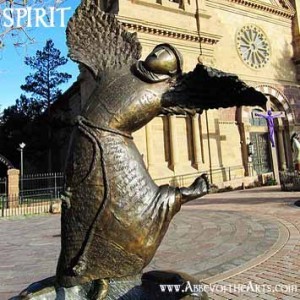 Sunday is the feast of Pentecost, that glorious final day of the season of resurrection. The Apostles were together experiencing bewilderment over how to move forward when the Holy Spirit flows among them and breathes courage into their hearts. If we have stayed committed to our pilgrimage this far then we may still wonder why we have journeyed so long and still are do full of fear and unknowing.
Sunday is the feast of Pentecost, that glorious final day of the season of resurrection. The Apostles were together experiencing bewilderment over how to move forward when the Holy Spirit flows among them and breathes courage into their hearts. If we have stayed committed to our pilgrimage this far then we may still wonder why we have journeyed so long and still are do full of fear and unknowing.
It says that those who witnessed this event were "amazed and perplexed." Some were confused, others cynical. Peter reminds the crowds of the words the prophet Joel declared, that all will be called to dreams and visions, all will need to be attentive to signs and wonders.
The story of Pentecost asks us a question: How do I let my expectations and cynicism close my heart to the new voice rising like a fierce wind?
In Benedictine tradition, conversion is a central spiritual practice. Conversion for me essentially means making a commitment to always be surprised by God. Conversion is the recognition that we are all on a journey and always changing. God is always offering us something new within us. Conversion is a commitment to total inner transformation and a free response to the ways God is calling us and to new images of God. Eugene Peterson describes it this way: "What we must never be encouraged to do, although all of us are guilty of it over and over, is to force Scripture to fit our experience. Our experience is too small; it's like trying to put the ocean into a thimble. What we want is to fit into the world revealed by Scripture, to swim in its vast ocean."
Several years ago I was going through an intense period of discernment. I had finished graduate school and found that my desires were no longer in alignment with the path I had initially imagined for myself. I spent long periods of time in silence and solitude, engaging all of the essential techniques for discernment I had learned in my studies and previous practice. I was taking this very seriously because this was my life path I was pondering. Then one night I had a dream about koala bears trying to get a map out of my hands so they could play with me. In my reflection time that followed I discovered a playful God who was calling me to take myself and my discernment far less seriously than I had been. I love to laugh but in my longing to discover the next path, I had forgotten what Merton reminds us in the opening quote: how playfulness is woven into the heart of the universe, how sometimes what God takes most seriously is what we easily dismiss.
Pentecost demands that we listen with a willing heart, and that we open ourselves to ongoing radical transformation. We discover that the pilgrimage does not end here, instead we are called to a new one of sharing our gifts with the world. Soul work is always challenging and calls us beyond our comfort zone. Prayer isn't about baptizing the status quo, but entering into dynamic relationship with the God who always makes things new. Scripture challenges our ingrained patterns of belief, our habitual attitudes and behavior. Conversion is about maintaining what the Buddhists call "Beginner's Mind." St. Benedict speaks to this in his Rule with the call to always begin again.
To be fully human and alive is to know the tension of our dustiness, our mortality, to be called to a profoundly healthy humility where we acknowledge that we can know very little of the magnificence of the divine Source of all. The Spirit descends on those gathered together in a small room and breaks the doors wide open. We are reminded that practicing resurrection is not for ourselves alone, but on behalf of a wider community. Not only for those with whom we attend church services, but beyond to the ones who sit at the furthest margins of our awareness. Pentecost is a story of the courage that comes from breaking established boundaries.
We may limit our vision through cynicism, but equally through certainty or cleverness. Sometimes we fear doubt so much that we allow it to make our thoughts rigid, we choose certainties and then never make space for the Spirit to break those open or apart. The things we feel sure that God does not care about may be precisely the source of healing for a broken world.
Life isn't about knowing with more and more certainty. This is the invitation of our creative practice as well, to move more deeply into the mystery of things. I find that the older I get, the less sure I am about anything and the richer my life becomes as I make space for unknowing, expansiveness, and possibilities far beyond my capacity for imagining. If when Pentecost arrives you do not find yourself perplexed or amazed, consider releasing the tight grip of your certain thoughts and make space for holy surprise.
At Abbey of the Arts, we are inviting the community to make a commitment to practice creativity daily in celebration of my new book being released in May 2015 The Soul of a Pilgrim: Eight Practices for the Journey Within (Ave Maria Press). Please join us (details available at this post).
With great and growing love,
Christine
Christine Valters Paintner, PhD
Click here to read this post at Patheos and share with others>
May 22, 2015
May 23: Transformation – Pilgrimage of Resurrection(A Creative Journey through the Easter Season)
Word for Today: Transformation
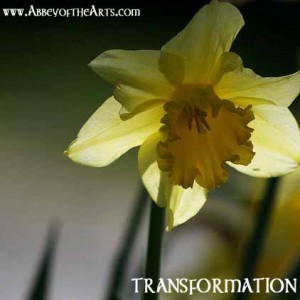 If entered into mindfully and with a whole heart, each encounter on the road has the potential to transform. The pilgrim returns home not with all the answers. Instead, they receive better questions; questions that bring the pilgrimage experience into daily life and reveal depth in all they see around them.
If entered into mindfully and with a whole heart, each encounter on the road has the potential to transform. The pilgrim returns home not with all the answers. Instead, they receive better questions; questions that bring the pilgrimage experience into daily life and reveal depth in all they see around them.
—Christine Valters Paintner, The Soul of a Pilgrim: Eight Practices for the Journey Within
Reflective Question: Can you stay open to the divine presence which is always in the midst of whatever life presents to you right here, right now, even if it is not what you were hoping for?
Next steps:
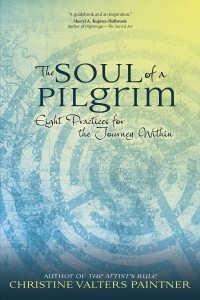 Let the word, quote, and question inspire your creative practice (Download the list of daily words here.) Use the hashtag #soulofapilgrim when sharing on social media.
Let the word, quote, and question inspire your creative practice (Download the list of daily words here.) Use the hashtag #soulofapilgrim when sharing on social media.Join the Holy Disorder of Dancing Monks Facebook group to share your art and writing with others.
Name your commitment to creative practice in the comments at this post (and enter the drawing to win a free copy of The Soul of a Pilgrim.)
Share this post with others and invite them to participate (they can sign up here)
Order a copy of Christine's newest book The Soul of a Pilgrim
Walk the Ancient Paths: Join us on pilgrimage to sacred landscapes>>
May 21, 2015
May 22: Home – Pilgrimage of Resurrection(A Creative Journey through the Easter Season)
Word for Today: Home
 Ultimately the pilgrimage leads us back home again. We always return bearing gifts for the community. We are always called back to share what we have been given with others.
Ultimately the pilgrimage leads us back home again. We always return bearing gifts for the community. We are always called back to share what we have been given with others.
—Christine Valters Paintner, The Soul of a Pilgrim: Eight Practices for the Journey Within
Reflective Question: What gifts are you bearing back from your pilgrimage? Who will you share them with?
Next steps:
 Let the word, quote, and question inspire your creative practice (Download the list of daily words here.) Use the hashtag #soulofapilgrim when sharing on social media.
Let the word, quote, and question inspire your creative practice (Download the list of daily words here.) Use the hashtag #soulofapilgrim when sharing on social media.Join the Holy Disorder of Dancing Monks Facebook group to share your art and writing with others.
Name your commitment to creative practice in the comments at this post (and enter the drawing to win a free copy of The Soul of a Pilgrim.)
Share this post with others and invite them to participate (they can sign up here)
Order a copy of Christine's newest book The Soul of a Pilgrim
Walk the Ancient Paths: Join us on pilgrimage to sacred landscapes>>
Monk in the World guest post: Sharon Landis
I am delighted to share another beautiful submission for the Monk in the World guest post series from the community. Read on for Sharon Landis's reflection on being powerfully ordinary:
I write constantly. I cannot stop writing as writing helps me process my life: helps me express my emotions rather than repress, helps me listen to my heart, express my faith, be gentle with my sensitives, and ask the hard questions. I sometimes dialogue with God through writing, after I’ve listened deeply. I write about everything, even about my dog, garden, grandchildren. Through expressive writing, I assist my soul in catching up to where the rest of me resides. Often, my body and mind move much faster than my inner being, my heart and soul. Solitude, silence and writing help me live more mindfully, provide the spaciousness my heart needs to remain open in this tumultuous, ever-changing world.
Lately, I’m playing with this silly title as a year-long journal intention: Thoughts from an Ordinary Prophet. I looked up the word prophet. None of the definitions are my intention. However, I could possibly see myself as a spokesperson for a cause or movement if the cause wants to increase our ability to love, laugh, notice and savor.
Of course, I need plenty of grace to embrace those four, especially when I’m in a bad mood and want to see the glass half empty. On the other hand, I’m fascinated by how everything I encounter in life can be my teacher, even crappy stuff like peevishness and picking up dog piles in my yard. Speaking of my dog, she could be a prophet since she teaches me how to be present, wag my tail more rather than growl, and be enticed by a good scent or trail through the woods!
If I am open to learning from everyone and everything, and share what I learn with tail wagging enthusiasm, I could be an ordinary oracle, a seer of the common and normal. In a world besotted with fame, grandeur and celebrities, someone in love with simplicity and normalcy could be refreshing.
I love the prayer: God help me want to be ordinary. It forces my idealism out of hiding so I can see all sides, both the shining and the shadow. I love the prayer because it shows me how to embrace my inability to change the world now. It means choosing the path less traveled, without attachment to accomplishments like having written a famous book or penning a highly quoted poem. It means standing by a line of trees, feeling sad they are going to be cut down, but sadder still that I took them for granted, never really noticing them before knowing of their fate.
The trees ask me: How much do I really honor and notice? How often do I sleep walk through life? How much to I dream of extraordinary while missing the beautifully ordinary?
These questions remind me of a poem I wrote when my heart was exquisitely aware of both my ability to love and my inadequacy:
Inadequate Gratitude
Wish I could scoop handfuls of glistening dew
and scatter the sparkles inside
or drape garlands of stars over doorways.
Wish I could capture delicious scents,
to perfume poverty and sadness with
jasmine, fresh rain, a crisp autumn day.
Wish I could spin the soulful trust of a puppy,
the quiet splendor of a misty morning,
and weave them into a beautiful tapestry.
Alas, all I have are my modest words,
my little soul, my limited heart
my inadequate bursts of gratitude.
I pray my offering expands as you receive
and becomes the wideness of the sky,
the freedom of a playful breeze…
the beat of a thousand hearts united
in a song of devotion,
souls soaked in grace, feasting on Love.
Perhaps enjoying a meaningful life really isn't a popularity contest. It could be that my ordinary self is extraordinary in ways I may not fully know. I’m sure the heart speaks in whispers while the ego and the world talk in shouts. Sometimes, when I read Marianne Williamson’s words, "Our deepest fear is not that we are inadequate. Our deepest fear is that we are powerful beyond measure,” it trips me up and makes me want to change the world again. Then I have to sit down and pray for the desire to be powerfully ordinary.
I always come back to believing who I am and doing what I love is enough. Perhaps sitting on a bench loving this fabulous earth, being awed by clouds and birds, honoring the life of the dead cat on the roadside, loving my dog, my family, myself, loving others, passing the wonder of stars and moon on to my grandchildren, laughing with the breeze, writing a blog or poetry is actually extra ordinary, and sharing my love of life is prophet-like. If so, then we’re all prophets. If we realized our power, the power of loving, laughing, noticing and savoring, the world would surely change, one ordinary prophet at a time.
 Sharon Clymer Landis is a writer, poet, blogger (at Color My Soul) and spiritual director known for her simplicity, gentle wisdom, compassion and love of stories. Sharon believes writing and telling our stories brings healing, humor and moves humanity toward greater compassion and wholeness. She lives on multi-generational farm in Lititz, Pennsylvania, with her husband and family.
Sharon Clymer Landis is a writer, poet, blogger (at Color My Soul) and spiritual director known for her simplicity, gentle wisdom, compassion and love of stories. Sharon believes writing and telling our stories brings healing, humor and moves humanity toward greater compassion and wholeness. She lives on multi-generational farm in Lititz, Pennsylvania, with her husband and family.
May 20, 2015
May 21: Relationship – Pilgrimage of Resurrection(A Creative Journey through the Easter Season)
Word for Today: Relationship
 God is never a set of concepts to be understood but a relationship to encounter. In this way, the spiritual life is
always
a journey. We do not let go once and for all.
God is never a set of concepts to be understood but a relationship to encounter. In this way, the spiritual life is
always
a journey. We do not let go once and for all.
—Christine Valters Paintner, The Soul of a Pilgrim: Eight Practices for the Journey Within
Reflective Question: Can you allow yourself the time and space to move through the layers of your life until you are living more from your heart than your mind?
Next steps:
 Let the word, quote, and question inspire your creative practice (Download the list of daily words here.) Use the hashtag #soulofapilgrim when sharing on social media.
Let the word, quote, and question inspire your creative practice (Download the list of daily words here.) Use the hashtag #soulofapilgrim when sharing on social media.Join the Holy Disorder of Dancing Monks Facebook group to share your art and writing with others.
Name your commitment to creative practice in the comments at this post (and enter the drawing to win a free copy of The Soul of a Pilgrim.)
Share this post with others and invite them to participate (they can sign up here)
Order a copy of Christine's newest book The Soul of a Pilgrim
Walk the Ancient Paths: Join us on pilgrimage to sacred landscapes>>
May 19, 2015
May 20: Holy Disruption – Pilgrimage of Resurrection(A Creative Journey through the Easter Season)
Word for Today: Holy Disruption
 The divine is that power which disrupts everything; it is at heart a great mystery at work.
The divine is that power which disrupts everything; it is at heart a great mystery at work.
—Christine Valters Paintner, The Soul of a Pilgrim: Eight Practices for the Journey Within
Reflective Question: What if our pilgrimage practice courted holy disruption? What if we embraced the unknown as sacred wisdom for the unfolding of our lives?
Next steps:
 Let the word, quote, and question inspire your creative practice (Download the list of daily words here.) Use the hashtag #soulofapilgrim when sharing on social media.
Let the word, quote, and question inspire your creative practice (Download the list of daily words here.) Use the hashtag #soulofapilgrim when sharing on social media.Join the Holy Disorder of Dancing Monks Facebook group to share your art and writing with others.
Name your commitment to creative practice in the comments at this post (and enter the drawing to win a free copy of The Soul of a Pilgrim.)
Share this post with others and invite them to participate (they can sign up here)
Order a copy of Christine's newest book The Soul of a Pilgrim
Walk the Ancient Paths: Join us on pilgrimage to sacred landscapes>>
May 18, 2015
May 19: Inner Landscape – Pilgrimage of Resurrection(A Creative Journey through the Easter Season)
Word for Today: Inner Landscape
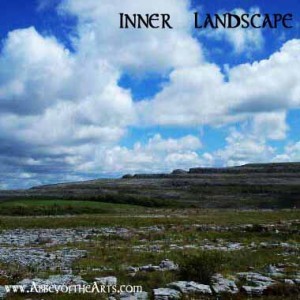 While some physical places and landscapes feel more like home to us, ultimately it is in service to us discovering the primal home within each one of us.
While some physical places and landscapes feel more like home to us, ultimately it is in service to us discovering the primal home within each one of us.
—Christine Valters Paintner, The Soul of a Pilgrim: Eight Practices for the Journey Within
Reflective Question: What would it be like to move through the world and, no matter where you found yourself, to recognize yourself as fully at home?
Next steps:
 Let the word, quote, and question inspire your creative practice (Download the list of daily words here.) Use the hashtag #soulofapilgrim when sharing on social media.
Let the word, quote, and question inspire your creative practice (Download the list of daily words here.) Use the hashtag #soulofapilgrim when sharing on social media.Join the Holy Disorder of Dancing Monks Facebook group to share your art and writing with others.
Name your commitment to creative practice in the comments at this post (and enter the drawing to win a free copy of The Soul of a Pilgrim.)
Share this post with others and invite them to participate (they can sign up here)
Order a copy of Christine's newest book The Soul of a Pilgrim
Walk the Ancient Paths: Join us on pilgrimage to sacred landscapes>>
May 17, 2015
May 18: Stranger – Pilgrimage of Resurrection(A Creative Journey through the Easter Season)
Word for Today: Stranger
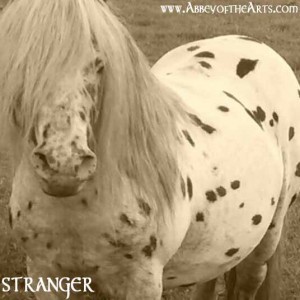 [
Benedict’s Rule calls me] to welcome in every stranger who comes to the door as the face of the divine…. At its core, it means that everything that seems strange, foreign, or uncomfortable is the place where God
especially
shimmers forth.
[
Benedict’s Rule calls me] to welcome in every stranger who comes to the door as the face of the divine…. At its core, it means that everything that seems strange, foreign, or uncomfortable is the place where God
especially
shimmers forth.
—Christine Valters Paintner, The Soul of a Pilgrim: Eight Practices for the Journey Within
Reflective Question: While it is relatively easy to see how this deep hospitality applies to strangers, can you see how it equally applies to an inner kind of hospitality, when we extend a welcome to the full spectrum of emotions, beliefs and thoughts which inhabit our hearts and minds? How does it make you feel when you realize that these are precisely the places where we are called to meet God?
Next steps:
 Let the word, quote, and question inspire your creative practice (Download the list of daily words here.) Use the hashtag #soulofapilgrim when sharing on social media.
Let the word, quote, and question inspire your creative practice (Download the list of daily words here.) Use the hashtag #soulofapilgrim when sharing on social media.Join the Holy Disorder of Dancing Monks Facebook group to share your art and writing with others.
Name your commitment to creative practice in the comments at this post (and enter the drawing to win a free copy of The Soul of a Pilgrim.)
Share this post with others and invite them to participate (they can sign up here)
Order a copy of Christine's newest book The Soul of a Pilgrim
Walk the Ancient Paths: Join us on pilgrimage to sacred landscapes>>




